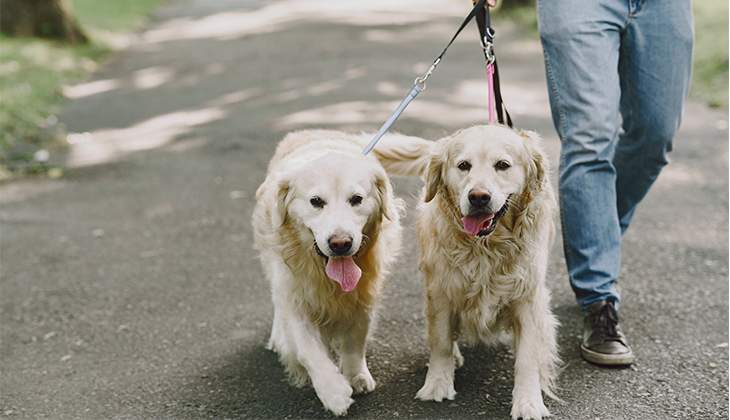Walking Your Dog
Those of us who have dogs know that walking is good for them, physically and mentally. The exercise is beneficial and they get mental stimulation from being outdoors, sniffing at neighbours’ gates and plants, with great enthusiasm. We also benefit physically from the exercise and psychologically from being outside with our furry friends. A researcher from the University of Liverpool, found that the main reason we take our dogs for walks is because it makes them happy, and when they are happy, we’re happy.
DOGS

Posted by bravectosouthafrica – 11 August 2021
Dog Walking – The Benefits
Taking the dog for a walk does not just provide exercise for dogs who have only a small garden in which to play. There are many other benefits, apart from keeping our doggies happy.
Physical Health
Dogs may put on excess weight, so obesity can be a problem. Regular walks help our dogs to stay slim, trim and healthy.
Joint Function
Lack of exercise and immobility can cause your doggie’s joints to become stiff. This can create many problems with their health. Walking moves the joints, keeping them healthy and preventing future problems.
Psychological Health
Going for a walk also exercises the mind and gives your dog something interesting to do. This may help to prevent destructive behaviour, like chewing your shoes. It is also important that your doggie burns up some of their excess energy – this will ensure a good night’s sleep.
Bonding With Your Dog
The companionship you and your dog experience when walking is invaluable in forming close bonds for both of you. This is perhaps the most important benefit of walking your dog. This time spent with your attention-grabbing pooch can also help to prevent behaviours such as too much barking and whining.

Mistakes When Walking Your Dog
What could go wrong? Taking a walk is simple: grab the leash and the dog and go. However, you may be making mistakes which might spoil the walk for your pooch.
- Don’t Rush Bathroom Stops!
Dogs urinate to send a message to other dogs: Hey, I’m here! So urination is not just to relieve themselves, it’s a way to communicate with other doggies in the neighbourhood. Smelling the other dogs’ urine tells your dog a lot about them, including their age, health and gender. As your dog walks they will want to sniff out the other dogs’ urine and also leave a sample of their own. So please don’t rush your doggie when performing this important behaviour.
- Stopping Sniffing
Dogs’ sense of smell is 10,000 times greater than ours, and it is the main way by which they find out about the world around them. The extent of the information they obtain by smelling is beyond our ability to understand.
When we prevent our dog from sniffing, such as by pulling them away from a fascinating scent or expecting them to heel for the entire walk, we are denying them the stimulation of their surroundings, which walking can provide.
However, many of us have experienced the dog who drives us crazy with the extent of their sniffing. There are ways of teaching your dog good walking behaviour. You could teach them cues such as “Munchkin, not now”, in order to distract them and bring their focus back to the walk. Don’t forget to reward them for coming to heel, by letting them have some sniffing sessions.
- Pulling On The Leash
Your dog is frantic to get to the next interesting smell, and they probably feel that you are too slow. They start to pull you and you almost always pull them back. This will only result in a pulling contest. Depending on the size of the dog, the chances are that you will eventually lose. You will quickly learn that if you pull on the leash, it is their instinct to pull back. Eventually, they may stop walking completely. Excessive dragging by the leash may in fact damage their throat, particularly if they are small or likely to suffer from a damaged trachea.
Ideally, your leash should hang in the shape of a letter “J”, between you and your dog. Having what is called a loose leash when you walk with your pooch will release the pressure on their throat and prevent dragging. To teach your dog to walk with a loose leash, when they get ahead of you, stop and then change direction. They will probably turn and catch up with you. Praise them and/or give them a treat. Only let them walk when the leash is slack. If they are still pulling, a training or head harness is worth thinking about.

Walking the Dog is Good for You!
Research has recently shown that doggie walkers are less likely to be obese than their couch-hugging friends. Doctors are advising that if we walk for 30 minutes a day, we will reduce our chances of getting osteoporosis, coronary heart disease, Type-2 diabetes, colon and breast cancer.
So, if you consider all these benefits, especially the fact that your dog loves it, then maybe a walk is a good idea, right now?
ZA-NON-210600002

Subscribe to our Newsletter
Get to know your furry friend better! Sign up for all things dog- or cat-related.
The Hairy Facts about the dreaded hairball
12 April 2021
Help! My dog’s barking mad! Volume 2
12 April 2021
Your Itchy, Scratchy Cat – All About Cat Skin Problems
12 April 2021
The Dog’s Diet: A Bone of contention?
01 April 2021
Mango Fly Worms: How to Spot and Eliminate them
Posted on November 28,2019
Managing Mange And Mites In Your Dog
Posted on June 11,2018
Why Do Cats Purr and How? Learn What Your Cat Is Saying
Posted on October 14,2020
How to Get Rid of Ear Mites in Dogs
Posted on November 06,2019









